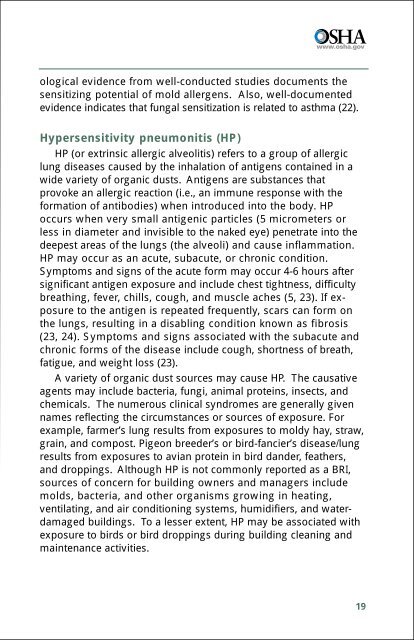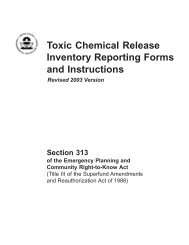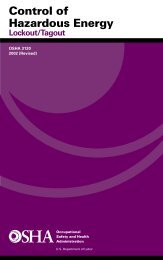Preventing Mold-Related Problems in the Indoor Workplace - Seton ...
Preventing Mold-Related Problems in the Indoor Workplace - Seton ...
Preventing Mold-Related Problems in the Indoor Workplace - Seton ...
Create successful ePaper yourself
Turn your PDF publications into a flip-book with our unique Google optimized e-Paper software.
ological evidence from well-conducted studies documents <strong>the</strong><br />
sensitiz<strong>in</strong>g potential of mold allergens. Also, well-documented<br />
evidence <strong>in</strong>dicates that fungal sensitization is related to asthma (22).<br />
Hypersensitivity pneumonitis (HP)<br />
HP (or extr<strong>in</strong>sic allergic alveolitis) refers to a group of allergic<br />
lung diseases caused by <strong>the</strong> <strong>in</strong>halation of antigens conta<strong>in</strong>ed <strong>in</strong> a<br />
wide variety of organic dusts. Antigens are substances that<br />
provoke an allergic reaction (i.e., an immune response with <strong>the</strong><br />
formation of antibodies) when <strong>in</strong>troduced <strong>in</strong>to <strong>the</strong> body. HP<br />
occurs when very small antigenic particles (5 micrometers or<br />
less <strong>in</strong> diameter and <strong>in</strong>visible to <strong>the</strong> naked eye) penetrate <strong>in</strong>to <strong>the</strong><br />
deepest areas of <strong>the</strong> lungs (<strong>the</strong> alveoli) and cause <strong>in</strong>flammation.<br />
HP may occur as an acute, subacute, or chronic condition.<br />
Symptoms and signs of <strong>the</strong> acute form may occur 4-6 hours after<br />
significant antigen exposure and <strong>in</strong>clude chest tightness, difficulty<br />
breath<strong>in</strong>g, fever, chills, cough, and muscle aches (5, 23). If exposure<br />
to <strong>the</strong> antigen is repeated frequently, scars can form on<br />
<strong>the</strong> lungs, result<strong>in</strong>g <strong>in</strong> a disabl<strong>in</strong>g condition known as fibrosis<br />
(23, 24). Symptoms and signs associated with <strong>the</strong> subacute and<br />
chronic forms of <strong>the</strong> disease <strong>in</strong>clude cough, shortness of breath,<br />
fatigue, and weight loss (23).<br />
A variety of organic dust sources may cause HP. The causative<br />
agents may <strong>in</strong>clude bacteria, fungi, animal prote<strong>in</strong>s, <strong>in</strong>sects, and<br />
chemicals. The numerous cl<strong>in</strong>ical syndromes are generally given<br />
names reflect<strong>in</strong>g <strong>the</strong> circumstances or sources of exposure. For<br />
example, farmer’s lung results from exposures to moldy hay, straw,<br />
gra<strong>in</strong>, and compost. Pigeon breeder’s or bird-fancier’s disease/lung<br />
results from exposures to avian prote<strong>in</strong> <strong>in</strong> bird dander, fea<strong>the</strong>rs,<br />
and dropp<strong>in</strong>gs. Although HP is not commonly reported as a BRI,<br />
sources of concern for build<strong>in</strong>g owners and managers <strong>in</strong>clude<br />
molds, bacteria, and o<strong>the</strong>r organisms grow<strong>in</strong>g <strong>in</strong> heat<strong>in</strong>g,<br />
ventilat<strong>in</strong>g, and air condition<strong>in</strong>g systems, humidifiers, and waterdamaged<br />
build<strong>in</strong>gs. To a lesser extent, HP may be associated with<br />
exposure to birds or bird dropp<strong>in</strong>gs dur<strong>in</strong>g build<strong>in</strong>g clean<strong>in</strong>g and<br />
ma<strong>in</strong>tenance activities.<br />
19
















